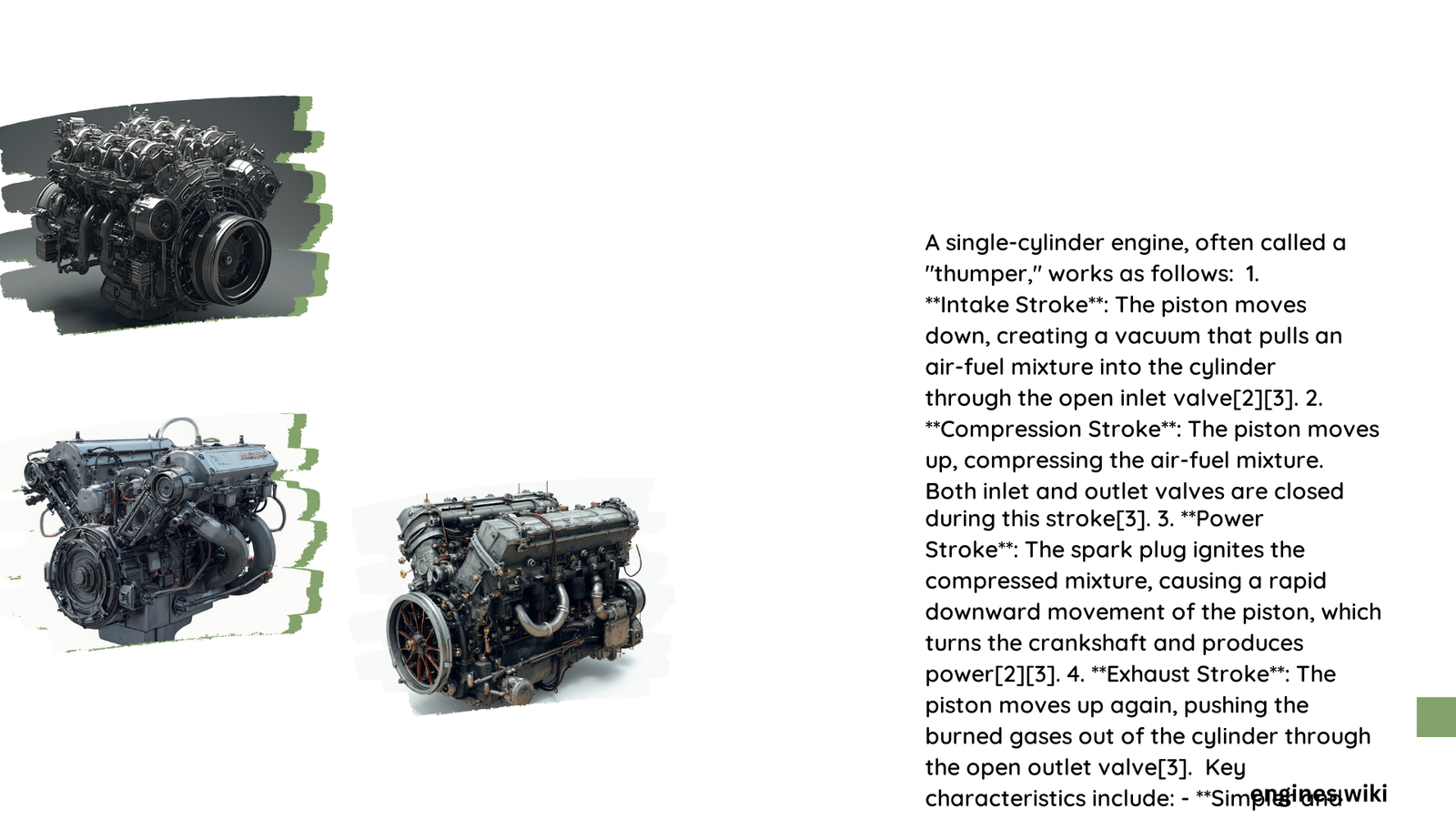A single cylinder engine is a simple yet powerful mechanical device that converts chemical energy from fuel into mechanical energy. It operates on a four-stroke cycle: intake, compression, combustion, and exhaust. The engine’s main components include a piston, cylinder, crankshaft, and valves. The piston moves up and down in the cylinder, driven by the explosive force of combustion, which is then converted into rotational motion by the crankshaft.
What Are the Main Components of a Single Cylinder Engine?
The key components of a single cylinder engine include:
- Piston
- Cylinder
- Crankshaft
- Valves (intake and exhaust)
- Connecting rod
- Cylinder head
- Spark plug (for gasoline engines)
- Fuel injector (for diesel engines)
Each of these components plays a crucial role in the engine’s operation. The piston moves within the cylinder, connected to the crankshaft via the connecting rod. The valves control the flow of air and fuel into the cylinder and the exhaust gases out of it.
How Does the Four-Stroke Cycle Work in a Single Cylinder Engine?

The four-stroke cycle is the heart of how a single cylinder engine works. Let’s break down each stroke:
- Intake Stroke:
- Piston moves downward
- Intake valve opens
-
Air (and fuel in gasoline engines) enters the cylinder
-
Compression Stroke:
- Piston moves upward
- Both valves close
-
Air (and fuel mixture in gasoline engines) is compressed
-
Combustion Stroke:
- In diesel engines: Fuel is injected and ignites due to high pressure and temperature
- In gasoline engines: Spark plug ignites the fuel-air mixture
-
Piston is forced downward
-
Exhaust Stroke:
- Piston moves upward
- Exhaust valve opens
- Exhaust gases are pushed out of the cylinder
This cycle repeats continuously as the engine operates, with each revolution of the crankshaft completing two strokes.
What’s the Difference Between Gasoline and Diesel Single Cylinder Engines?
While both gasoline and diesel single cylinder engines follow the four-stroke cycle, they differ in several key aspects:
| Aspect | Gasoline Engine | Diesel Engine |
|---|---|---|
| Fuel Ignition | Spark plug | Compression ignition |
| Compression Ratio | Lower (8:1 to 10:1) | Higher (18:1 to 22:1) |
| Fuel Injection | During intake stroke | At the end of compression stroke |
| Efficiency | Generally lower | Generally higher |
| Power Output | Typically lower | Typically higher |
Diesel engines tend to be more efficient and produce more torque, but they are also heavier and more expensive to manufacture.
How Does the Ignition System Work in Single Cylinder Engines?
The ignition system varies depending on whether it’s a gasoline or diesel engine:
Gasoline Engines:
- Spark plug generates a spark
- Ignition coil provides high voltage (5,000 to 30,000 volts)
- Spark timing is crucial (typically 10-30 degrees before top dead center)
Diesel Engines:
- No spark plug required
- Fuel injector sprays fuel into highly compressed air
- Spontaneous ignition occurs due to high temperature and pressure
What Are the Efficiency Metrics of a Single Cylinder Engine?
Efficiency metrics help evaluate the performance of a single cylinder engine:
- Thermal Efficiency:
- Ratio of work output to heat input
- Diesel engines: 30% to 40%
-
Gasoline engines: Generally lower
-
Fuel Consumption:
- Varies widely based on application and engine design
-
Example: Small diesel engine might consume 2-5 liters per hour
-
Power Output:
- Ranges from a few kilowatts to tens of kilowatts
- Small diesel engine: 5-20 kW (6.7-26.8 horsepower)
- More powerful engines: Up to 50 kW (67 horsepower) or more
What Are the Common Challenges and Failure Points in Single Cylinder Engines?
Single cylinder engines face several challenges and potential failure points:
- Air-Fuel Mixture Ratios:
- Critical for gasoline engines (ideal ratio around 14.7:1)
-
Less critical for diesel engines, but proper fuel injection is crucial
-
Compression Ratios:
- Affects efficiency and power output
-
Higher ratios increase efficiency but also risk of engine knock
-
Common Failure Points:
- Piston rings and cylinders: Wear leads to reduced compression
- Valves: Wear or improper timing affects performance
- Fuel injectors: Clogging disrupts combustion
- Lubrication system: Poor lubrication causes wear and overheating
Understanding these challenges helps in proper maintenance and troubleshooting of single cylinder engines.
How Can Single Cylinder Engine Performance Be Optimized?
To optimize the performance of a single cylinder engine:
- Regular maintenance:
- Change oil and filters as recommended
- Keep fuel system clean
-
Check and adjust valve clearances
-
Proper tuning:
- Ensure correct ignition timing
-
Optimize air-fuel mixture
-
Use quality fuel and lubricants
-
Consider aftermarket improvements:
- High-flow air filters
- Performance exhaust systems
- Engine management systems for fine-tuning
By addressing these aspects, you can ensure your single cylinder engine operates at its best efficiency and power output.
Understanding how a single cylinder engine works is crucial for proper operation, maintenance, and troubleshooting. Whether it’s a small lawnmower engine or a larger industrial application, the principles remain the same. By grasping these concepts, you’ll be better equipped to handle any single cylinder engine you encounter.
References:
1. https://www.hiearns-power.com/new_detail/single-cylinder-air-cooled-diesel-engine.html
2. https://www1.grc.nasa.gov/beginners-guide-to-aeronautics/engine-mechanical-operation/
3. https://www.grc.nasa.gov/www/k-12/airplane/engintk.html
